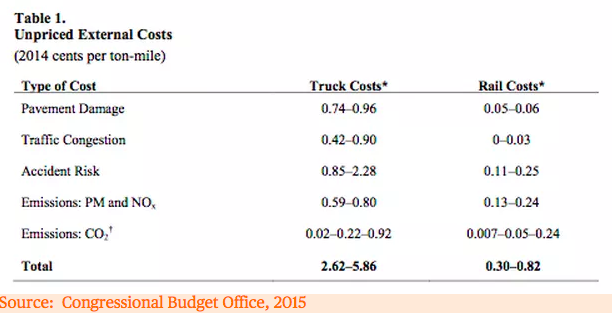Lots to chew on in this eye opening post from Joe Cortright, President and principal economist of Impresa, a consulting firm specializing in regional economic analysis, innovation and industry clusters. The subject – the true costs of a high concentration of freight traffic – is ultra relevant to a Lehigh Valley that has gone “all in” on logistics warehouses.
Remember, in the next 5 years we’re planning on spending 250 million+ dollars – strike that guess we are up to 800 million+ dollars – to widen Rt. 22. When it’s all said and done the nearly – and likely eventually to be over – billion dollar mega-project is a response to projections that the Valleys freight traffic will double in the next 20 years.
Focusing on that freight traffic a moment…According to the Congressional budget office: “Truck freight movement gets a subsidy of between $57 and $128 billion annually in the form of uncompensated costs, over and above what trucks pay in taxes”
The widening of Rt. 22 is a big part of that taxpayer subsidization of the warehouse industry. Remember, the bulk of 2.5 billion coming to the Valley is a result of the +.28 gas tax bandaid and other increases in other user fees in Pennsylvania. Increasing gas taxes is a well I’m convinced we’ll be perpetually pressured to dip into over and over until we fundamentally reform the way we fund roads. It is a short sighted bandaid that I’m happy many local reps voted against.
Smart growth is making sure the balance of land uses in your municipality generate enough revenue to mitigate the costs of liabilities. This is a fundamental way to keep property taxes low long term. With the Valleys warehouse economy we unfortunately have a concentration of buildings that not only don’t pay for themselves but rather generate massive un-funded liabilities. Now, school districts salivate over these mega shell buildings of course. (A rational but also desperate response to a broken and inequitable education funding system.) Problem is, in the grand scheme chasing warehouse revenue is basically robbing Peter to pay Paul since the decrease in school taxes is negated with a disproportionate increase in municipal and other taxes. Here in the East Penn area warehouse developers actually double dipped since the East Penn School District was hoodwinked into paying for a major multi million dollar local road expansion.
What’s the answer? Well for one right sizing the revenue we collect from high liability land uses. Problem is in PA we have very little in the way of tools to do this locally.
Now someone inevitably always says, “well you shop Amazon”. Yes, I am guilty. Love Amazon. But as Joe Cortright points out if the subsidy plug was pulled then shipping companies would naturally and creatively respond. That’s how the market works. Personally, I would gladly pay a little more for my weekly amazon packages. The doorstep convenience would still be well worth it.
I’d also realize savings elsewhere since it’s likely any cost increases to my Amazon bill would also be offset since massive subsidies:
In other words, take away the subsidies and force the shippers to get more innovative and efficient. These innovations are coming someday anyhow but with the massive subsidies in place the industry is not motivated.

